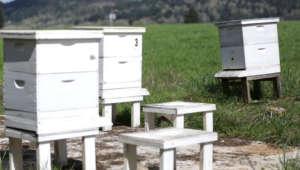Updated: January 18, 2023
“All the workers are girls.” That’s the first thing King Estate Garden Manager Jessie Russell tells a visitor about the bees. Jessie, who doubles as beekeeper, smiles and continues, “The drones are the males.”
She’s not making this up. It’s a fact of life in the bee world. The drones exist to mate with the queen, who in turn produces eggs that produce more workers. And what do all these workers eat in the winter, when fruits and flowers are no longer in bloom? Why, honey of course.
Fortunately for us humans, bees make more honey than they need to survive. The hard-working bees at King Estate provide about 300 pounds of honey a year for use in our restaurant.
While bees are prized for their role in pollination, they actually aren’t necessary for growing wine grapes. Grapevines are unusual in the botanical world in that they don’t need bees to produce fruit. In order for most fruit to grow, nature relies on bees and other pollinators to gather and deposit pollen as they go from flower to flower. With grapes, wind carries the pollen from vine to vine, with no role for bees.
Beekeeping and Winemaking
But bees are an important worker on King Estate nonetheless. King Estate is a diverse, self-contained ecosystem that is farmed organically and sustainably. In addition to 465 acres of wine grapes, the estate boasts 26 acres of orchards, lavender and gardens for vegetables, herbs and flowers. So much to pollinate! Our diligent bees are up to the task.
Beekeeping wasn’t part of Jessie’s repertoire when she came to work at King Estate in 2005. To get up to speed, she enrolled in a master beekeepers course at Oregon State University. One thing she’s learned: “You don’t really keep bees; bees keep you.”
On this day she is preparing to check the hives to see if the frames inside are filling up with honey.
The bee hives are wood boxes about the size of a microwave oven, painted white. There are four in the garden near the greenhouses. Bees – thousands of them – can be seen coming and going through the numerous holes drilled into the sides.

Inside the hives are racks, called frames, that look like picture frames around honeycomb that is made of wax or plastic. The bees deposit honey and eggs on the frames. In the spring and summer every seven to 10 days, Jessie dons her bee suit and inspects the hives, checking to make sure the bees are happy and healthy, with room to grow.
Room to grow is imperative. When frames become crowded with brood or full with honey, the queen will follow her natural inclination to “swarm.” Swarming is the natural method of colony reproduction. In the spring, following a frenzy of laying eggs and raising brood, the queen begins preparations to leave the hive. When she does, she takes half or more of the workers with her to seek out a new home.
Beekeeping and Sustainability
The remaining workers will begin to establish a new queen that will repopulate the hive. A beekeeper’s hope for surplus honey to harvest is dashed with the loss of half of the work force. So the bee keeper spends countless hours in efforts to prevent swarming. These methods include splitting hives, moving frames, and rotating boxes among other complex manipulations.
Sometimes it works… and sometimes it doesn’t. To quote Winnie-the-Pooh, “You never can tell with bees.”
Pooh was right. Amid widespread concern over the disappearance of honeybees and wild bees, it’s only natural that King Estate would do its part to assure that pollination happens and honey flows. The whole beekeeping enterprise can be summed up in one word: Sweet!
